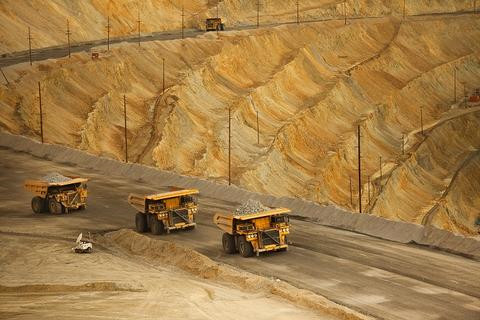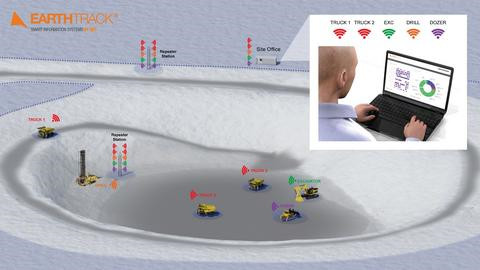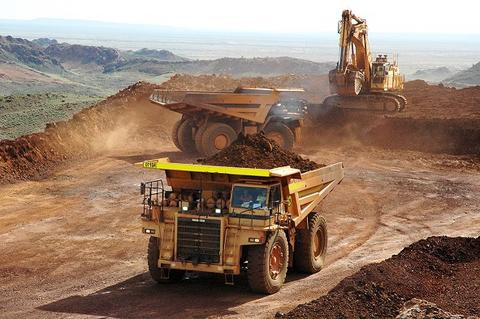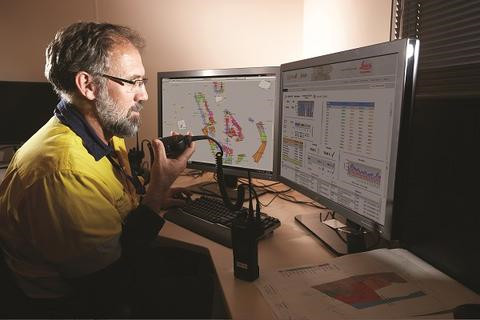
Carly Leonida examines how IoT-enabled technologies are changing the way mine fleets are managed.
Even up until 10 years ago, when the term fleet management was used, it would generally refer to the application of a fleet management system or FMS. Introduced by the likes of Modular Mining in the 1970s, FMSs initially oversaw the dispatching of trucks and loaders at open-pit mining operations, helping to increase equipment utilisation and reduce the cost per tonne of material moved.
Fast forward nearly 50 years, and ‘fleet management’ now encompasses so much more than just ensuring the right truck is at the right shovel at the right time. Now the scope includes whatever the management of a fleet could entail, including collision avoidance, selective digging, predictive maintenance and analytics, as well as assistive and even unmanned machine operation.
In turn, the products available for fleet management have evolved, and so have the technologies enabling their capabilities. Whereas separate, vendor-specific systems were once the norm for each different area of fleet management, the most important terms to look for now are integration and interoperability; why buy just a dispatch system when you can have one which also incorporates traffic safety and ore-blending technologies, one which is automation-ready and offers the benefits of both cloud and edge computing? Put differently, one which can help deliver the efficiencies major miners such as Rio Tinto and BHP are seeing in the Pilbara region of Western Australia at mid-tier and junior operations in far flung locations.
“Fleet management systems have come a long way from solving just vehicle bunching and queues at the shovels and loaders,” Brendon Lilly, product manager- new solutions at Hexagon Mining, tells Mining Magazine. “Thanks to near-ubiquitous wireless and radio connectivity at mine sites, modern-day FMSs have expanded in scope to solve many more problems.
“Hexagon Mining, for instance, offers products that help mines make real-time, smart decisions for everything from fuel consumption and route planning to scheduling of crews and maintenance.”
Now dispatchers can make decisions based on parameters such as traffic on the road, fuel usage, and tyre temperature. Whether tyres are getting warmer or cooler will determine which type of route vehicles are sent on, and the type of material being excavated and loaded into the truck is also optimised. Mines that blend together different ore grades can time their excavation so that the blending takes place live at the crusher, rather than stockpiling ore first.
“It’s part of a general trend towards helping mines make better use of their data to lower costs and increase efficiencies,” Lilly adds.
Clever communications
There are a number of trends that have enabled the growth and optimisation of fleet management practices, but the most important by far is improvement in mine communications systems, especially for underground operations.
Having the correct communication system in place facilitates the seamless exchange of data between machines and users, and the introduction of mesh, Wi-Fi, cellular (3G/4G) and fixed position satellite networks have led to near real-time availability of production and utilisation information, allowing decision makers to assess and adjust operations in a more timely manner.
Dave Holman, head of product management at RCT Global, explains: “Communications systems have completely changed the way in which companies manage their fleets; transforming businesses by empowering decision makers with the relevant information needed to make smarter, profit-boosting decisions in both the short- and long-term.”
The ability to collect and analyse machine operating data via an FMS allows miners to quickly determine if their fleet is being operated within the correct parameters, and when certain components/units are likely to require maintenance. Access to real-time production data also allows optimisation of downstream operations such as processing, resulting in lower energy consumption and better metal recoveries. In short, operations become holistically more efficient and productive.
Knowing where every machine is with high accuracy has revolutionised mine productivity and safety.
While fleet management has now broken away from the traditional dispatch-only mentality, the next step for mining companies is to use fleet management technology to harness IoT-enabled systems such as cloud and edge computing. These will allow selective digging depending on grade, and semi/full automation of mining operations.
That’s where the next big productivity gains lie.
High-precision positioning
One of the biggest steps forward in fleet management has come from the introduction of high-precision positioning technology or high precision GNSS as it is sometimes known.
Mehran Motamed, CEO at Rigid Robotics, explains: “Fleet management’s core services are based on the positioning or ‘localisation’ of assets, and as mines have become increasingly interested in using technology to optimise their operations, GPS accuracy (typically plus/minus 5m at the mine surface) has become insufficient.”
The advent of high-precision positioning therefore opened new possibilities for fleet management providers.
“It enables mines to do selective digging, especially in gold operations,” says Motamed. “Combine high-precision positioning with a high precision heading component and you can determine which stockpile trucks are dumping their ore onto, even when stockpiles are tightly clustered together.
“You can plan an exact path for earthmoving machines such as dozers to create better roads and loading areas. High-precision positioning and heading is a must have in predictive collision avoidance.”
High-precision positioning and heading are also a building block of autonomy and therefore a necessity for fleet management at mines which have future plans for a semi and/or fully-autonomous fleet.
The technologies have gone through a cost reduction in recent years and are now more readily available in smaller forms.
“These systems are now cheaper and in most cases have better overall performance,” Motamed tells MM. “Previously, larger companies dominated the market with solutions that would range from US$30k-$50k for large equipment such as shovels. Now there are ruggedised solutions for mining at below $5k.”
Motamed explains that the company is seeing strong demand from its customers for reduced cycle times, optimal fleet operation, reduced operating costs and better tracking of ore and assets.
“Additionally, mines not only want to have a better understanding of what’s going on in their operation, but also are moving into an era where data, information, and knowledge are not enough (as they have plenty generated already),” he says. “More and more, they want decision making to be done by software algorithms that run right on their machines or in their control centres.
“We provide high-precision positioning/heading and a suite of applications that use this information for traffic safety, assistive operation, and unmanned operations. This is a large scope in practice, so we are focusing on where we see a lot of demand and that’s at the beginning of the autonomy curve. While high-precision positioning and collision avoidance are in focus now, we see clients wanting technology that will allow them to move towards automation as quickly as possible.”
Satellite systems
High-precision positioning goes hand in hand with satellite communications; another area which has come to play a critical role in mine fleet management, and especially automation.
Joe Carr is director of mining at Inmarsat Enterprise. The company owns the only global network of fixed satellite receivers and so is well positioned to speak to developments in this area.
“Most miners already have mesh networks in their mines,” says Carr. “Customers are now coming to us saying ‘it works, but we’re experiencing issues because the network is so critical that the downtime in the network has become unacceptable’.”
He explains in more detail: “Take the example of some of the big Pilbara mines where Rio Tinto and BHP are moving 320Mt+ a year. A half hour stoppage for them costs about US$500,000 and they cannot rely purely on terrestrial communications, because if those trucks stop that’s an incredibly expensive loss.
“They’re coming to us saying their production is so important that they require a network with such high uptime and reliability that should anything happen to their terrestrial network- a storm or power failure for example- they can keep running. That, for us, is the driving force behind what we’re seeing.”
The rise of autonomous equipment has meant that satellite communications are becoming ever more critical in fleet management. “In the past, it wasn’t so bad because there was always a driver in the truck who could jump on the radio and say ‘my system isn’t working, where do I need to go?’” says Carr. “But with autonomous equipment, that option isn’t always there. If the system goes down there is no driver to fall back on, so reliability becomes incredibly important.”
Most satellite-based systems comprise a network of low-orbit satellites which are constantly moving. The trouble with these is that there isn’t always a satellite to connect to; miners might have to wait five minutes for a satellite to pass overhead and then switch to a different one as the satellite moves away from them.
“There’s a handover period,” Carr explains. “And if that handover doesn’t go correctly or if the network is busy then you might lose connection. We have a network of satellites which are static, so as long as you can see the sky and point the aerial at the satellite then there is a stable connection.”
Inmarsat is the only company that offers a global network of static satellites, but there are plenty of regional players too.
“We launched a satellite about 2-3 months ago at a cost of half a billion dollars, and currently we have 11 satellites active in the sky. The twelfth, which we just launched, was to provide in-air Wi-Fi for planes,” Carr adds. “We are now on our fifth generation which provides high-speed internet on fixed ground sites. We also offer BGAN- broadband global area network- that’s a small mobile terminal with an aerial that you can put on top of a vehicle and it gives you broadband speed, and that’s what we see mining companies primarily after.”
Many mines build a mesh network based on Wi-Fi, radio frequency and cellular channels but are looking to add satellite for backhaul reliability. In addition to automation, the network speed and capability has also enabled better data management and analytics through cloud and edge computing.
“If you look at the level of data mines are now producing and the crunching that it has to go through with an autonomous system with its LiDAR and multiple sensor networks, what you see is that the big mining companies have that capability in house and they’re building big data centres to handle it,” Carr tells MM. “Where we see advances being made is in taking that capability and pivoting it out to mid-tier miners and juniors. For them, it’s about taking that data and not necessarily cloud computing it themselves on their own data servers, but having that done by someone else and then them having access to that data.
“We want to take what guys like Rio and BHP are doing in the Pilbara with their autonomous truck fleets and enable that through satellite communications in West Africa at a mid-tier gold mining operation that doesn’t have access to that technology at the moment because the capability simply isn’t there.”
This is a big growth area for companies like Inmarsat at present. A gold producer in West Africa might have a cost per tonne of US$1,100/oz. With the gold price where it stands, if that mine can lower its costs by even US$100 dollars, then it may add 50-100% to its margin. Having trucks run 24h/d instead of 20h/day could mean a 15-20% increase in production and that could make or break a project, or make one that’s marginal much more profitable.
Cloud thinking
Backed by a stable network connection, cloud computing gives companies the ability to host and manage large quantities of data off-site. This, in turn, enables better analytics and the ability to aggregate data across multiple mine sites and even across multiple companies.
“Emerging technologies such as the cloud are having a big effect on mine dispatch practices,” Holman tells MM. “It is allowing a very effective means of giving greater access to machine data. However, there are challenges associated with its use, which includes being able to maintain control of the data leaving the local area. On the upside, having this information available on the cloud means decisions can be made on and off site to ensure site and company objectives are met.”
By removing the additional IT overheads associated with managing their own server hardware infrastructure and server software backup and maintenance, the cloud is helping mid-tier and junior miners to leverage the benefits of big data; something previously only within the reach of the largest and richest mining houses.
“We’re seeing interest in creating data centres which aren’t in specific locations,” Carr explains. “With the cloud, you can potentially take multiple aggregated data feeds from different mining companies and look at reliability across a specific type of truck, for example a 240t Caterpillar truck. Why just rely on your own mines’ data when you could rely on multiple data feeds to help flag up when you might expect to see a maintenance issue?”
Inmarsat recently published a report entitled ‘The future of IoT in enterprise 2017’. This surveyed 500 senior respondents from across the agritech, energy production, transportation, and mining sectors, at organisations over 1,000 employees in size.
“42% of the companies that came back to us, nearly half, said that connectivity issues are what’s really holding back their IoT deployment,” says Carr. “We see issues especially in remote areas or areas where it’s difficult to get skilled workers. It’s all very well and good rolling out automated trucks at a mine in the Peruvian Andes or in the Philippines for example, but if you can’t get the staff to maintain the fleet it’s going to be very expensive and inefficient.”
He continues: “The skills shortage for where mining is going with the rise of machines and automation, it’s only going to get worse. The boom and bust cycle really hollows out the middle of mining; there are always graduates and the guys that have been there 30-40 odd years, but you lose the middle section due to recession, people losing their jobs and going elsewhere.
“And mining’s going through a technological revolution at the moment. It’s no good just being a mining engineer anymore, you need to be an engineer who understands automation and the cloud and edge computing. Companies are looking to buy that skill in, which is fine, but if people with those skills don’t exist within the industry at that time… That’s where were seeing a huge push from the majors- they all have innovation departments.”
Automation and remote operations
This is where remote operations centres and automation come into play, where dispatchers can work remotely -perhaps in a capital city- potentially attracting a bigger pool of candidates for these types of roles.
Remote centres also make it easier for sites to scale up, as operators can manage multiple vehicles when they are not tied to one specific machine. Martin Politick, director of product development at Wenco International Mining Systems, explains that this is especially useful in the case of a mine expansion, where extra equipment comes online, or when additional pits are opened.
Automation will continue to change the way mobile fleets are managed. The technology is evolving rapidly and deployment will continue to increase as more and more companies look to remove the inconsistencies from their businesses.
“Machine data will only enhance this and the key will be to be able to maintain the two in unison,” Holman explains.
In developed mining markets such as Australia and Canada, automation offers the potential to stay competitive despite high operational costs.
“A truck driver in Australia costs A$200-250k a year, and you need 2.5 drivers per truck for 100 trucks at a mine, with the same on your trains and drills rigs, plus you need maintenance staff,” explains Carr. “That’s why we see Canada and Australia really driving innovation growth; because of where they sit on the cost curve. These mines have to be competitive with their production costs, and the only way they can do that is by driving production growth and getting more tonnes out for less.”
He continues: “How that technology flows across the globe is going to be more interesting. And how will the developed market adapt their new equipment and leverage IoT to reduce their costs again and get that 5-10 year advantage that iron-ore mines in the Pilbara currently have? Those producers currently own the seaborne iron-ore market and in order to maintain that, they are going to have to seriously innovate.”
Automation and improved fleet management practices will eventually lead to the point where FIFO operations become a thing of the past. Operators and dispatchers will be travelling to remote operations centres and driving five trucks at the same time, and this will eliminate the FIFO lifestyle and social issues associated with mine camps which contribute to high workforce turnovers.
Mine design will also change to incorporate narrower haul roads, steeper pit angles and reduced stripping ratios. Switching to automated haulage could immediately enable a 15-20% productivity gain because equipment can run 365 days a year; forget shutting for two days over Christmas, there’s an extra 2Mt at stake.
Ready for disruption?
So what’s next in fleet management? Even better communications will be the first step with faster, more reliable wireless in the pit and a lower cost of connectivity for more remote sites.
Mobile devices will also continue to be key. “Prior to smartphones, on board/mobile computing was reserved for very few, because the software infrastructure to manage intermittent connectivity was not provided free of charge like it is today on Android. Reliable and ‘low enough cost’ hardware was simply not available off-the-shelf and had to be engineered in-house at a high cost. Cheap smartphones and their tablet offspring have completely changed that landscape,” Politick says.
Interoperability will also be crucial. “For future mines that won’t operate as one big system, I believe we will see the fleet management space disrupted by a collection of smaller systems with open application programming interfaces (API) running open-source software, and with open protocol communication and a large emphasis on connectivity,” says Motamed.
As the intelligence level of software algorithms and their output quality improves (or at least is able to mimic those of humans), it is likely that we will also see human operators and dispatchers shift up in decision-making roles, leaving more decisions to be made by machines.






Comments (0)